How to Test Moisture in Concrete Floors
Testing for moisture in concrete floor slabs could sound daunting, so we’ve made this easy-to-follow concrete moisture testing guide just for you.
Before we start, let’s debunk this idea: the calcium chloride (CaCl) testing method is sufficient for moisture testing. No, it is not.
The CaCl method (standardized today as ASTM F1869) was first established in the 1940s with no real basis in scientific research. Since it only measures the slab’s surface, you’re not getting an accurate forecasting picture. It tells you what’s happening now on the surface, but as a general contractor or flooring contractor, your job’s success is based on what happens in the future—after you lay the flooring.
You must use the in situ relative humidity (RH) test method to get this necessary information.
Here’s why:
When the concrete is still drying, moisture levels on the surface read lower than in the center of the slab. But when you seal your concrete and lay the flooring, the moisture inside the slab will equilibrate (disperse evenly). This means the moisture hidden below could rise toward the top and damage your hard work.
To avoid guessing how much moisture is actually in the concrete slab, you should use RH testing, which reads deeper in the concrete than the CaCl method.
Scientific research determined that testing at 40% of the slab’s depth for concrete drying from one side (20% if drying from two sides) would best predict the final slab RH levels—if it were sealed by a low permeable material then.
Knowing the accurate RH level of the slab can prevent potential moisture-related flooring failure.
Before you start testing, your space should be enclosed with the HVAC up and running.
6 Steps: How to Test for Concrete Moisture
1. Install Smart Logger and Log 48 Hours Before Testing
Use one per zone of conditioned space where concrete will be tested.
2. Use C555 to Identify Areas with the Highest Comparative Moisture
Use only on smooth surfaces.
Note: Do not use alone as it only measures the top, “drier” part of the slab
3. Install Rapid RH L6 Smart Sensors
Use a hammer drill and masonry drill bit to drill holes at 40% depth in concrete if drying from one side.
Use a wire brush, vacuum, and attachment to clean out holes.
Place the required number of sensors targeting areas with the highest moisture levels over the rest of the concrete slab. Place at least three sensors for the first 1,000 sq. ft. and one more per additional 1,000 sq. ft.
4. Use the DataMaster L6 app to Create a Map of Sensor Locations
Upload your floor plans and easily add sensor locations on the map. Name each sensor to keep an accurate record of the data for each sensor.
5. Transfer Data from RH Sensor
Use the DataGrabber with Bluetooth to easily get your sensor data to your phone. Otherwise, use the Total Reader to transfer your RH readings to the DataMaster L6 app.
6. Analyze Data and Determine What the Concrete Slab Needs
The concrete slab might need additional drying time. Should you need to take repeat readings, you can do so immediately. The Smart Logger, DataGrabbers, and L6 sensors will continue to operate and store data for months.
What is an acceptable moisture level in concrete?
The ASTM F710 standard says the concrete slab needs to be below 75% relative humidity, or whatever RH level the floor covering manufacturer specifies. Some products can handle 80% RH, and some even up to 90%.
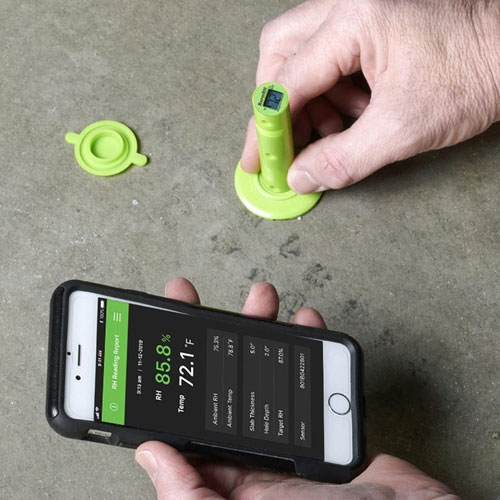
The Rapid RH Total Reader is a handy device that can wirelessly transfer your RH data to the DataMaster L6 app on your smartphone.
Once you get your readings, it’s time to make the call on whether or not to proceed with installing the floor covering.
Check the floor covering manufacturer’s website for specifics on RH levels, or visit www.rhspec.com for a list of most products with links to the manufacturer website.
The patented Rapid RH® Smart Sensor design is superior to other RH test methods. For one, the Rapid RH L6 single-use sensor is permanently embedded into the concrete, making it easy to obtain fast, accurate RH readings consistent with ASTM F2170 and drastically cutting down on otherwise required paperwork and regular calibration checks.
If you want to know even more about your moisture situation, you can do this: combine the Smart Logger™, C555 Concrete Moisture Meter, and Rapid RH L6 System to measure and log ambient temperature and RH. This cocktail of tools is unbeatable for fast, accurate moisture testing that will protect your job and give you peace of mind.
Tools for Testing Moisture in Concrete
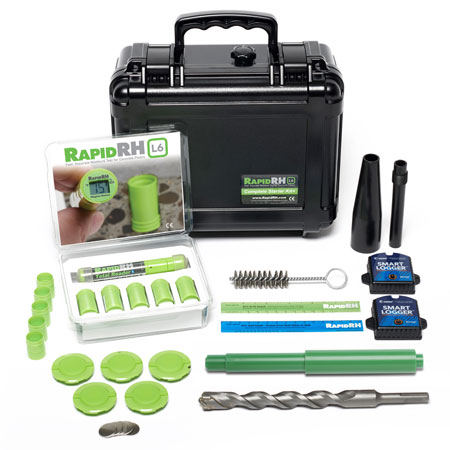
This Starter Kit for the Rapid RH L6 system gives you exactly what you need to easily conduct in situ RH testing.
The Rapid RH L6 Starter Kit comes with everything you need to get started: including two Smart Logger recorders, five Rapid RH L6 Smart Sensors, and a Total Reader®, along with the necessary attachments/tools.
Here’s the full list of what’s included in the Starter Kit. If you need any of the individual items, each item is also available here.
In addition to the Starter Kit, you’ll also want to use these tools:
- C555 Concrete Moisture Meter
- Smart Logger app, available for any iOS or Android device
- DataMaster™ app, available for any iOS or Android device
- Hammer drill
- Vacuum
What are Concrete Moisture Testing Tools, and Why Do I Need Them?
Smart Logger
When the concrete slab is enclosed with a running HVAC, it’s time to install your Smart Logger.
The Smart Logger requires very little setup. Since it’s small and needs no power connection, it can be placed anywhere (use one in each area of differing ambient conditions).
Once set up, the Smart Logger starts taking ambient temperature and RH measurements on a pre-programmed schedule. Allow 48 hours of logging time to show correct, stable ambient conditions. Up to 12,000 recordings can be stored on the device and easily accessed through the Smart Logger app.
The free Smart Logger app is available for any IOS or Android device. Access your recordings via Bluetooth® with the option to generate, print, and email PDF reports of the readings.
When the logger shows favorable conditions have been in place for 48 hours, it’s time to determine where to place the in situ probes.
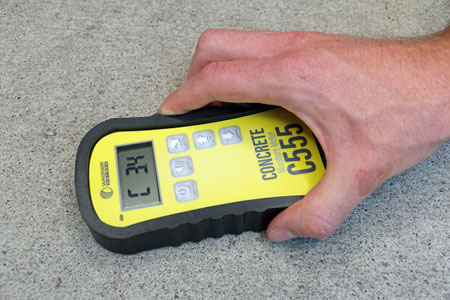
The C555 Concrete Moisture Meter provides a useful tool for determining where to place your in situ RH probes.
C555 Concrete Moisture Meter
A good way to find where to put in situ probes is by using the C555 meter.
In compliance with ASTM F2659, the C555 measures concrete moisture in seconds. Its built-in sensors also take measurements of ambient temperature and RH.
When placed on the smooth, flat surface of the slab, the C555 provides fast, non-destructive “wet/dry” qualitative moisture measurements. These measurements show where potential problem areas are, giving you a good indication of where to install the Rapid RH L6 Smart Sensors.
Rapid RH L6 Smart Sensors
The Rapid RH L6 Smart Sensors is in situ concrete testing probes that are highly accurate and fully comply with F2170.
These sensors come factory calibrated with a NIST-traceable certificate of calibration and never need recalibration.
Their advanced technology means easier testing and faster results. The Smart Sensors go 40% into the concrete slab, and each sensor needs 24 hours of equilibration time. After they’re installed, there’s no need to transfer them and no need for additional equilibration time. Repeat readings can be taken easily—no extra time or effort is required.
All Rapid RH L6 Smart Sensors come with an ASTM F2170 test results sheet. This sheet gives documentation of the required data: floor map of the sensor location, sensor recording, depth, and dates and times of RH readings.
Download this form here. If you want the full version—including an ASTM F2170 checklist—download this one.
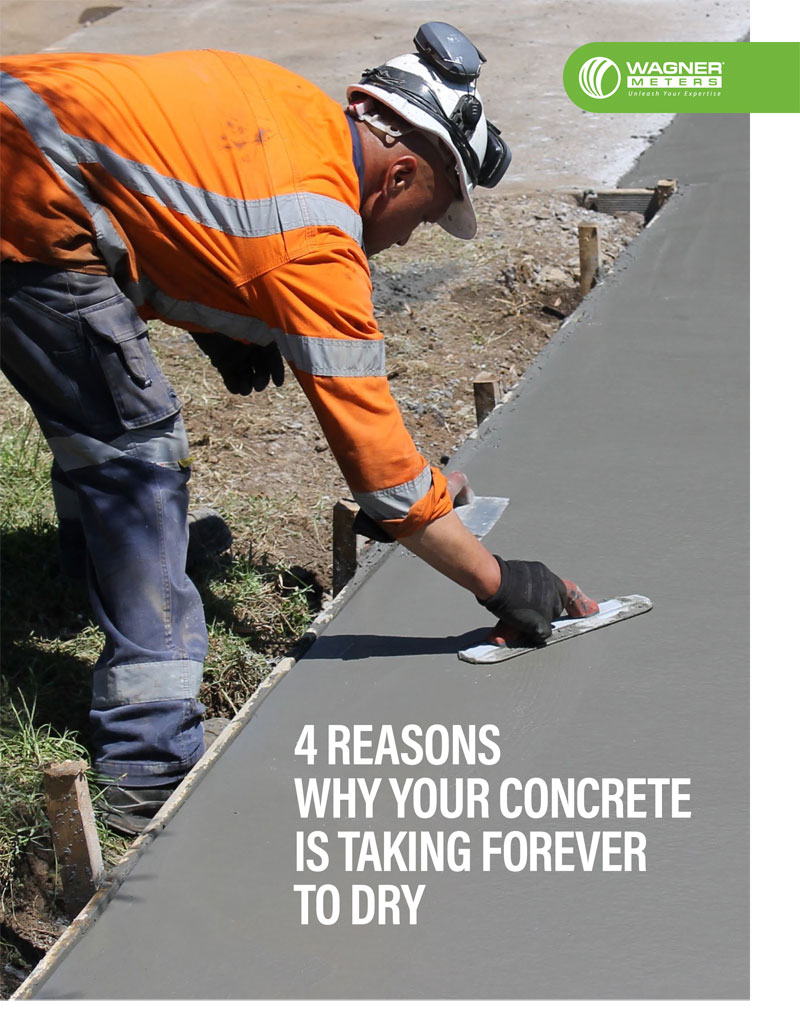
Free Download – 4 Reasons Why Your Concrete Is Taking Forever to Dry
Total Reader
When sensors are in place and equilibrated, the Total Reader is what connects the sensors wirelessly to your smartphone.
The Total Reader pulls data from the Smart Sensors and sends it to the free DataMaster L6 app (available for any IOS or Android device). From the app, you can create time-stamped PDF data reports for clients.
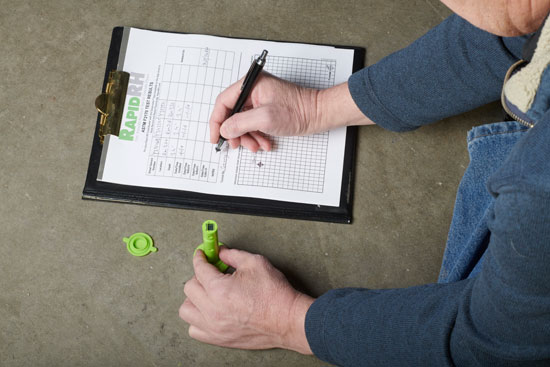
With the Rapid RH system, you can use either the ASTM F2170 test results sheet or a digital app for recording all your RH data.
This provides you with the highest data integrity and lets you sleep easy knowing you’re covered.
To purchase the tools necessary for accurate concrete moisture testing, visit the online Rapid RH store. For more information about RH testing or any of the Rapid RH L6 system tools, call the Rapid RH specialists at Wagner Meters. Available worldwide toll-free at 800-933-3506.
Jason has 20+ years’ experience in sales and sales management in a spectrum of industries and has successfully launched a variety of products to the market, including the original Rapid RH® concrete moisture tests. He currently works with Wagner Meters as our Rapid RH® product sales manager.
Related Posts via Taxonomies
Last updated on August 30th, 2022




Jason, I just purchased and used the RHL6. I have 2 questions
1) When I did an initial 1-hr read, the meter showed the RH of 77 and slab temp showed ‘H’, no number – what does that mean?
2) Where do I get the blank ‘ASTM F2170 Test Results’ sheets that have the RapidRH header?
Rick:
Thanks for the questions. The “H” would typically be a miscommunication between the reader and the sensor plate. I would expect it to clear out the next reading. Please let me know if you see additional issues. The test result page can be found at Rev C- L6 RRH Floor Map revised 05-07-19 (https://www.wagnermeters.com/pdf/RRHL6-floor-map.pdf). Good luck.